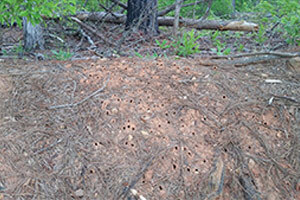
Last month I talked about honey bee colony defense and explained how stinging is simply the culminating act of a cascade of previous actions in which worker bees detect a threat to the nest, appraise it, alert nestmates to the hazard, direct a number of threatening acts toward the invader, and attack the invader only if these prior measures do not repel it. Like an immune response, a defensive response is a costly endeavor, and it is counterproductive to instantly leap to its ultimate expression – stinging – because in the case of honey bees stinging is a suicidal act. Evolution, ever unwaveringly and radically practical, is a study in tradeoffs between benefits and risks, and because of this we can think of the outcomes of evolution, not as perfect solutions, but as optimum solutions to a particular problem. The defense cascade is adapted to maximize the probability of preserving the colony at the lowest cost in terms of lost bees.
The existence of a cascade also highlights the fact that a bee colony experiences a range of dangers of increasing intensity. An invading insect is not as dangerous as a human predator, and the cascade permits a range of responses scaled to the danger.
Ordinary human experience also makes clear that nest defense differs according to the life history of the insect. It’s no accident that it’s the social wasps and bees that elicit the largest and most frightening defense reactions. A solitary mud dauber wasp certainly possesses the hardware; females possess stings which they use to paralyze spiders and feed to their larvae. However, human stings from mud daubers are exceedingly rare. The same is true of virtually all solitary wasps and bees, including cicada killers, miner bees, carpenter bees, potter bees, and mason bees. It’s not that solitary bees don’t have predators and parasites, it’s just that it is too risky for a solitary fertile female to engage in direct confrontation with a predator. It’s far safer to abandon that nest and attempt another one elsewhere. This is also why solitary bees, especially soil nesting miner species, tend to nest in large aggregations near one another (Figures 1 and 2). The mass aggregation lowers the risk for any one nest being attacked by a predator or parasite. Every spring at county extension offices all over the country the telephones ring with homeowners concerned at the sudden appearance of “swarming bees in my backyard” which are really the busy mating and foraging flights of a solitary bee aggregation. For a few brief days every year the intensity of their localized flight can rival that of a strong honey bee hive, and the concentration of their burrows gives the false appearance of a social colony. Yet a human observer can walk through them unscathed like a boat cleaving water. Despite appearances, the bees are solitary – each an autonomous reproductive female unwilling to risk her life attacking a large predator.
So we’ve already begun tracing the earliest steps of an evolutionary roadmap for honey bee nest defense. No nest defense at all, the solitary bees show us, is a reasonable option if the individual is the sole reproductive agent and nest-making is relatively cheap: flight over fight. However, to this humble beginning it’s easy to add the first refinement – nesting together in large aggregations. This improves the benefit : risk equation by lowering risk – the likelihood that any one burrow will be attacked, just like herd behavior lowers the likelihood of any one wildebeest being attacked by the lion.
But things start changing rapidly once the species begins moving up the road toward sociality. Long-term readers of this column may remember a point I made back in February 2015 that the venerable sociobiologist E.O. Wilson spelled out three ascending criteria for eusociality, or true sociality: (1) cooperative brood care, such that individuals share one nest and help tend the common brood, (2) reproductive division of labor, such that some individuals abandon reproduction in order to help others reproduce, and (3) overlapping generations.1 As lineages of species move up this gradient it’s possible for some to express only steps 1 or 2. The first step, cooperative brood care, happens when two or more reproductive females, perhaps a mother and daughter, begin sharing one burrow. This moment in evolutionary history was recalled in my May 2015 column when I pointed out that a daughter of a singly-mated (to one male) mother can pass on 50% of her genes in one of two ways – by staying at the nest and helping her mother raise more of her siblings, or by striking out on her own – and from the discussion in April 2015 we know that staying and defending a common nest is a powerful benefit not to be rejected lightly.
So it is no overstatement to say that nest defense was there at the beginning; it helped…


